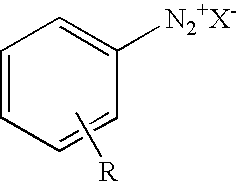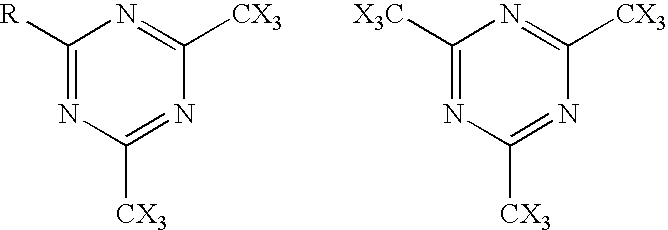Method and apparatus for chemical and biochemical reactions using photo-generated reagents
a photo-generated reagent and chemical and biochemical technology, applied in the field of parallel synthesis and assay of biopolymers, can solve the problems of inconvenient and expensive approach, high setup cost of making a new chip, and use of photomasks
- Summary
- Abstract
- Description
- Claims
- Application Information
AI Technical Summary
Benefits of technology
Problems solved by technology
Method used
Image
Examples
third embodiment
[0153] FIG. 9C illustrates an isolation mechanism contemplated by of the present invention. In this embodiment, a pattern of non-wetting film 933 is coated on the surface of a transparent solid substrate 931. During an operation, a reactor assembly comprising said transparent solid substrate 931 is first filled with a solution 934. Then solution 934 is drained from the reactor assembly resulting in the formation of isolated droplets on solid substrate 931 because the solution 934 fails to adhere to said non-wetting film 934. A controlled light pattern 935 is projected onto transparent solid surface 931 thus illuminating droplets 934a and 934c to initiate photolytic and other PGR mediated reactions. This embodiment is particularly advantageous by eliminating the need for a sealing mechanism and is suitable for large-scale microarray or biochip production using large substrates. The use of non-wetting films to confine fluid is well-known in the art and has been described by Thomas M. ...
example i
Production of Acid Photogenerated Reagent
[0191] This experiment demonstrates efficient generation of H.sup.+ upon illumination of an acid PGR as monitored by an increased value in the chemical shift of the H.sub.2O signal as a function of illumination time.
[0192] Six samples containing a sulfonium salt (0.4% of 50% triaryl sulfonium hexaflurophosphate in propylene carbonate, Secant Chemicals, Boston, Mass.) in. 0.5 mL CD.sub.2Cl.sub.2 were placed in nuclear magnetic resonance (NMR) tubes. A reference one-dimensional (ID) spectrum of these samples was recorded (600 MHz NMR spectrometer, Bruker, Karlsruhe, Germany) using a method well known to those skilled in the art. One of the samples was then illuminated using a collimated light source (22 mW, Oriel, Stanford, Calif.) at 365 nnm for a defined length of time (FIG. 13) and a 1D NMR spectrum was recorded immediately. A second sample was then illuminated at 365 nm for a second defined length of time (FIG. 13) and a 1D NMR spectrum was...
example ii
Deprotection of Nucleoside Monomers using Acid PGR
[0194] These experiments demonstrate efficient deprotection of the DMT group on 5'-OH of nucleosides using an acid PGR.
[0195] Two samples were prepared in which DMT-G attached to (controlled porous glass, 0.2 pmol (CPG) added to sulfonium salt (0.4% of 50% triaryl sulfonium hexaflurophosphate in propylene carbonate, Secant Chemicals, Boston, Mass.) in 0.5 mL CH.sub.2Cl.sub.2. One sample was illuminated using a UV lamp (UVGL-25, 0.72 mW) at 365 nm for 2 min, while the other sample, a control, was not illuminated. Upon completion of the illumination, CPG was washed with CH.sub.2Cl.sub.2 and CH.sub.3CN, followed by treatment with concentrated aqueous NH.sub.4OH (1 mL) for 2 h at 55.degree. C. The solution was briefly evaporated under vaccuum. A buffer solution (0.1 M triethylammonium acetate (TEAA), 15% in CH.sub.3CN) was added to the CPG sample and the resultant solution was injected into a C18 reverse phase (10 pm, .mu.-bondapak, Wate...
PUM
| Property | Measurement | Unit |
|---|---|---|
| Volume | aaaaa | aaaaa |
| Volume | aaaaa | aaaaa |
| Volume | aaaaa | aaaaa |
Abstract
Description
Claims
Application Information
 Login to View More
Login to View More - R&D
- Intellectual Property
- Life Sciences
- Materials
- Tech Scout
- Unparalleled Data Quality
- Higher Quality Content
- 60% Fewer Hallucinations
Browse by: Latest US Patents, China's latest patents, Technical Efficacy Thesaurus, Application Domain, Technology Topic, Popular Technical Reports.
© 2025 PatSnap. All rights reserved.Legal|Privacy policy|Modern Slavery Act Transparency Statement|Sitemap|About US| Contact US: help@patsnap.com



